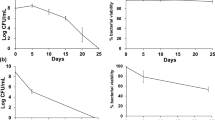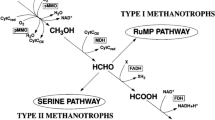Abstract
The proteins encoded by the hgcA and hgcB genes are currently the only ones known to be involved in the mercury methylation by anaerobic microorganisms. However, no studies have been published to determine the relationships between their expression level and the net/gross methylmercury production. This study aimed to decipher the effect of growth conditions on methylmercury production and the relationships between hgcA and hgcB expression levels and net methylation. Desulfovibrio dechloroacetivorans strain BerOc1 was grown under sulfidogenic conditions with different carbon sources and electron donors as well as under fumarate respiration. A good correlation was found between the biomass production and the methylmercury production when the strain was grown under sulfate-reducing conditions. Methylmercury production was much higher under fumarate respiration when no sulfide was produced. During exponential growth, hgcA and hgcB gene expression levels were only slightly higher in the presence of inorganic mercury, and it was difficult to conclude whether there was a significant induction of hgcA and hgcB genes by inorganic mercury. Besides, no relationships between hgcA and hgcB expression levels and net mercury methylation could be observed when the strain was grown either under sulfate reduction or fumarate respiration, indicating that environmental factors had more influence than expression levels.




Similar content being viewed by others
References
Bae HS, Dierberg FE, Ogram A (2014) Syntrophs dominate sequences associated with the mercury methylation-related gene hgcA in the water conservation areas of the Florida Everglades. Appl Environ Microbiol 80:6517–6526
Barkay T, Wagner-Döbler I (2005) Microbial transformations of mercury: potentials, challenges, and achievements in controlling mercury toxicity in the environment. Adv Appl Microbiol 57:1–52
Benoit JM, Gilmour CC, Mason RP (2001) The influence of sulfide on solid-phase mercury bioavailability for methylation by pure cultures of Desulfobulbus propionicus (1pr3). Environ Sci Technol 35:127–132
Biswas A, Brooks SC, Miller CL, Mosher JJ, Yin XL, Drake MM (2011) Bacterial growth phase influences methylmercury production by the sulfate-reducing bacterium Desulfovibrio desulfuricans ND132. Sci Total Environ 409:3943–3948
Bordenave S, Goñi-Urriza M, Vilette C, Blanchard S, Caumette P, Duran R (2008) Diversity of ring-hydroxylating dioxygenases in pristine and oil contaminated microbial mats at genomic and transcriptomic levels. Environ Microbiol 10:3201–3211
Borges V, Ferreira R, Nunes A, Nogueira P, Borrego MJ, Gomes JP (2010) Normalization strategies for real-time expression data in Chlamydia trachomatis. J Microbiol Methods 82:256–264
Boudou A, Ribeyre F (1997) Mercury in food webs: accumulation and transfer mechanisms. Metal Ions Biol Syst 34:289–319
Braaten HFV, de Wit HA, Fjeld E, Rognerud S, Lydersen E, Larssen T (2014) Environmental factors influencing mercury speciation in Subarctic and Boreal lakes. Sci Total Environ 476–477:336–345
Bridou R, Monperrus M, Rodriguez Gonzalez P, Guyoneaud R, Amouroux D (2011) Simultaneous determination of mercury methylation and demethylation capacities of various sulfate-reducing bacteria using species-specific isotopic tracers. Environ Toxicol Chem 30:337–344
Bustin SA, Benes V, Garson JA, Hellemans J, Huggett J, Kubista M, Mueller R, Nolan T, Pfaffl MW, Shipley GL, Vandesompele J, Wttwer CT (2009) The MIQE Guidelines - Minimum Information for Publication of Quantitative Real-Time PCR Experiments. Clin Chem 55:611–622
Compeau GC, Bartha R (1985) Sulfate-reducing bacteria: principal methylators of mercury in anoxic estuarine sediment. Appl Environ Microbiol 50:498–502
Gilmour CC, Elias DA, Kucken AM, Brown SD, Palumbo AV, Schadt CW, Wall JD (2011) Sulfate-reducing bacterium Desulfovibrio desulfuricans ND132 as a model for understanding bacterial mercury methylation. Appl Environ Microbiol 77:3938–3951
Gilmour CC, Podar M, Bullock AL, Graham AM, Brown S, Somenahally AC, Johs A, Hurt R, Bailey KL, Elias D (2013) Mercury methylation by novel microorganisms from new environments. Environ Sci Technol 47:11810–11820
Graham AM, Aiken GR, Gilmour CC (2013) Effect of dissolved organic matter source and character on microbial Hg methylation in Hg-S-DOM solutions. Environ Sci Technol 47:5746–5754
Ivask A, Hakkila K, Virta M (2001) Detection of organomercurials with sensor bacteria. Anal Chem 73:5168–5171
Ivask A, Rolova T, Kahru A (2009) A suite of recombinant luminescent bacterial strains for the quantification of bioavailable heavy metals and toxicity testing. BMC Biotechnol 9:41
Jay JA, Murray KJ, Gilmour CC, Mason RP, Morel FM, Roberts AL, Hemond HF (2002) Mercury methylation by Desulfovibrio desulfuricans ND132 in the presence of polysulfides. Appl Environ Microbiol 68:5741–5745
Jonsson S, Skyllberg U, Nilsson MB, Lundberg E, Andersson A, Björn E (2014) Differentiated availability of geochemical mercury pools controls methylmercury levels in estuarine sediment and biota. Nat Commun 5:4624
Kerin EJ, Gilmour CC, Roden E, Suzuki MT, Coates JD, Mason RP (2006) Mercury methylation by dissimilatory iron-reducing bacteria. Appl Environ Microbiol 72:7919–7921
King JK, Kostka JE, Frischer ME, Saunders FM (2000) Sulfate-reducing bacteria methylate mercury at variable rates in pure culture and in marine sediments. Appl Environ Microbiol 66:2430–2437
Liu YR, Yu RQ, Zheng YM, He JZ (2014) Analysis of the microbial community structure by monitoring an Hg methylation gene (hgcA) in paddy soils along an Hg gradient. Appl Environ Microbiol 80:2874–2879
Moberly JG, Miller CL, Brown SD, Biswas A, Brandt CC, Palumbo AV, Elias DA (2012) Role of morphological growth state and gene expression in Desulfovibrio africanus strain Walvis Bay mercury methylation. Environ Sci Technol 46:4926–4932
Parks JM, Johs A, Podar M, Bridou R, Hurt RA Jr, Smith SD, Tomanicek SJ, Qian Y, Brown SD, Brandt CC, Palumbo AV, Smith JC, Wall JD, Elias DA, Liang L (2013) The genetic basis for bacterial mercury methylation. Science 339:1332–1335
Perrot V, Bridou R, Pedrero Z, Guyoneaud R, Monperrus M, Amouroux D (2015) Identical Hg isotope mass dependent fractionation signature during methylation by sulfate-reducing bacteria in sulfate and sulfate-free environment. Environ Sci Technol 49:1365–1373
Pham ALT, Morris A, Zhang T, Ticknor J, Levard C, Hsu-Kim H (2014) Precipitation of nanoscale mercuric sulfides in the presence of natural organic matter: structural properties, aggregation, and biotransformation. Geochim Cosmochim Acta 133:204–215
Poulain AJ, Barkay T (2013) Cracking the mercury methylation code. Sciences 339:1280–1281
Ranchou-Peyruse A, Moppert X, Hourcade E, Hernandez G, Caumette P, Guyoneaud R (2004) Characterization of brackish anaerobic bacteria involved in hydrocarbon degradation: A combination of molecular and culture-based approaches. Ophelia 58:255–262
Ranchou-Peyruse M, Monperrus M, Bridou R, Duran R, Amouroux D, Salvado JC, Guyoneaud R (2009) Overview of mercury methylation capacities among anaerobic bacteria including representatives of the sulphate-reducers: implications for environmental studies. Geomicrobiol J 26:1–8
Rigaud S, Di Giorgio C, Radakovitch O, Garnier JM, De Meo M (2012) Genotoxicity of sediment extracts of the Berre lagoon (France). Chemosphere 88:937–944
Ritz M, Garenaux A, Berge M, Federighi M (2009) Determination of rpoA as the most suitable internal control to study stress response in C. jejuni by RT-qPCR and application to oxidative stress. J Microbiol Methods 76:196–200
Rodriguez-Gonzalez P, Monperrus M, Alonso JIG, Amouroux D, Donard OFX (2007) Comparison of different numerical approaches for multiple spiking species-specific isotope dilution analysis exemplified by the determination of butyltin species in sediments. J Anal At Spectrom 22:1373–1382
Rodriguez-Gonzalez P, Epov VN, Bridou R, Tessier E, Guyoneaud R, Monperrus M, Amouroux D (2009) Species-specific stable isotope fractionation of mercury during Hg(II) methylation by an anaerobic bacteria (Desulfobulbus propionicus) under dark conditions. Environ Sci Technol 43:9183–9188
Schaefer JK, Morel FMM (2009) High methylation rates of mercury bound to cysteine by Geobacter sulfurreducens. Nat Geosci 2:123–126
Schaefer JK, Rocks SS, Zheng W, Liang L, Gu B, Morel FMM (2011) Active transport, substrate specificity, and methylation of Hg(II) in anaerobic bacteria. Proc Natl Acad Sci U S A 108:8714–8719
Schaefer JK, Kronberg RM, Morel FMM, Skyllberg U (2014) Detection of a key Hg methylation gene, hgcA, in wetland soils. Environ Microbiol Rep 6:441–447
Sim MS, Ono S, Donovan K, Templer SP, Bosak T (2011) Effect of electron donors on the fractionation of sulfur isotopes by a marine Desulfovibrio sp. Geochim Cosmochim Acta 75:4244–4259
Truong HY, Chen YW, Belzile N (2013) Effect of sulfide, selenite and mercuric mercury on the growth and methylation capacity of the sulfate reducing bacterium Desulfovibrio desulfuricans. Sci Total Environ 449:373–384
U.N. Environment Programme DTI/1636/GE (2013) Mercury, Time to act. http://www.unep.org/PDF/PressReleases/Mercury_TimeToAct.pdf
Widdel F, Bak F (1992) Gram-negative mesophilic sulfate-reducing bacteria. In: Balows A, Trüper HG, Dworkin M, Harder W, Schleifer KH (eds) The prokaryotes, 2nd edn. Springer Verlag, New York, pp 3352–3378
Acknowledgments
This work was supported by the CNRS-INSU EC2CO (Biomer Project). Authors acknowledge Angela Ivask for kindly providing the E. coli MC1061 biosensor.
Compliance with ethical standards
The authors declare no conflicts of interest. All authors have been informed about this publication and have given their consent. This research did not involve Human Participants and/or Animals.
Author information
Authors and Affiliations
Corresponding author
Additional information
Responsible editor: Philippe Garrigues
Electronic supplementary material
Below is the link to the electronic supplementary material.
Supplementary Table 1
(DOC 26 kb)
Rights and permissions
About this article
Cite this article
Goñi-Urriza, M., Corsellis, Y., Lanceleur, L. et al. Relationships between bacterial energetic metabolism, mercury methylation potential, and hgcA/hgcB gene expression in Desulfovibrio dechloroacetivorans BerOc1. Environ Sci Pollut Res 22, 13764–13771 (2015). https://doi.org/10.1007/s11356-015-4273-5
Received:
Accepted:
Published:
Issue Date:
DOI: https://doi.org/10.1007/s11356-015-4273-5




